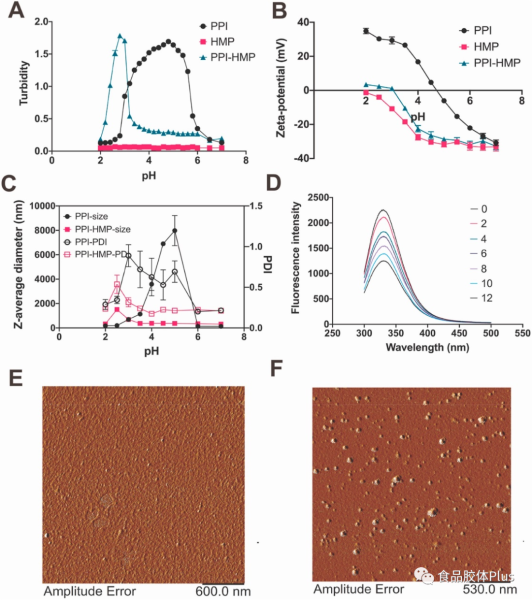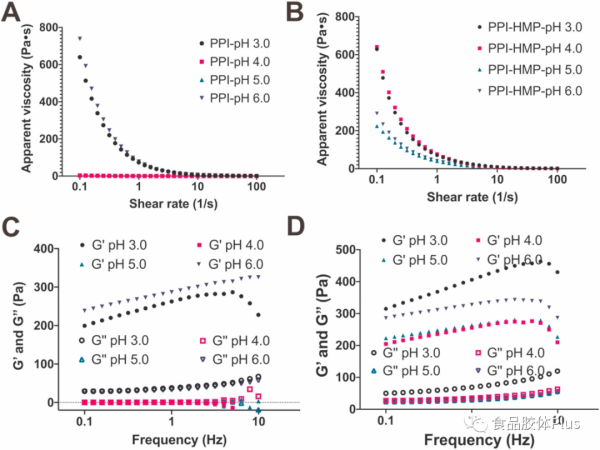The demand for novel delivery systems with natural biopolymers is increasing in recent years to stabilize and deliver a wide range of biologically active and functional nutrients. Protein-polysaccharide colloidal particles have shown great potential in stabilizing and delivering hydrophobic actives loaded high internal phase Pickering emulsions (HIPPEs).
In this study, composite colloidal particles (PPI-HMP) of pea protein isolate (PPI) and high methoxy pectin (HMP) were prepared and used to stabilize and deliver β-carotene-loaded HIPPEs. The stability of HIPPEs with pH changes was systematically investigated. The microstructure, viscoelasticity, and potential stabilization mechanisms of HIPPEs with PPI and PPI-HMP complexes were characterized by optical microscopy, rheology, and confocal laser scanning microscopy. Then PPI-HMP composite colloidal particles were used to stably encapsulate, protect and deliver β-carotene (BC) with optimized HIPPEs to explore the application prospects of HIPPEs in encapsulating and delivering bioactive compounds.
Characteristics of PPI-HMP composite colloidal particles
The effect of pH (2.0-7.0) on turbidity, Zeta potential and particle size of individual biopolymers (PPI and HMP) and PPI-HMP colloidal complexes was evaluated. As shown in Figure 1A, the turbidity of HMP was close to zero and was not affected by pH changes; the turbidity of PPI was greatest at approximately pH 4.6, indicating the formation of a large number of aggregates. In the pH range of 2.8–6.5, the turbidity of the PPI-HMP complex solution was significantly lower than that of PPI, indicating that the addition of HMP to the PPI solution significantly reduced PPI-PPI aggregation. In the pH range of 2.8–4.8, soluble PPI-HMP colloidal complexes were formed mainly through electrostatic interactions; while at pH > pI, soluble complexes were formed through positively charged plaques on the surface of pectin and PPI-PPI clusters. Tiny electrostatic attraction between the blocks. At pH 2.8, the PPI-HMP complex exhibited the greatest turbidity due to the overall charge neutralization of the biopolymer complex.
The addition of HMP to the PPI solution significantly reduced the aggregation of PPI-PPI in the pH range of 3.0-5.5 and resulted in a significant reduction in particle size, indicating the formation of PPI-HMP colloidal complexes.
The effect of different concentrations of HMP on the fluorescence intensity of PPI was investigated at pH 3.0 and the results are shown in Figure 1D. As the HMP concentration increased from 0 to 12 μg/mL, the fluorescence intensity gradually decreased and the maximum absorption wavelength underwent a slight red shift, indicating that the complexation between PPI and HMP was due to increased electrostatic interactions, and the tryptophan residues exposed to a more hydrophobic environment.

The microscopic morphologies of PPI and PPI-HMP composite colloidal particles at pH 6.0 observed by atomic force microscopy are shown in Figure 1E-F. Both PPI and PPI-HMP colloidal particles were spherical and uniformly dispersed, and the particle size of PPI-HMP composite colloidal particles increased significantly.
Formation, characteristics and microstructure of HIPPEs
pH significantly affects the formation and stability of HIPPEs stabilized with PPI. PPI-stabilized HIPPEs were more stable at pH 3.0 and 6.0; emulsions at pH 4.0 and 5.0 produced 10% creaming after 1 day and de-oiled after 3 days. This is mainly due to the significant reduction in electrostatic repulsion, with the formation of large protein aggregates at pH around 4.8. Notably, the PPI-HMP colloidal particle-stabilized HIPPEs were highly stable regardless of pH changes. The oil droplet diameters of PPI-HMP-stabilized HIPPEs were 41.8, 42.2, 55.0 and 38.3 μm at pH 3.0, 4.0, 5.0 and 6.0, respectively. Optical microscopy images showed that all PPI-HMP colloidal particle-stabilized HIPPEs oil droplets were spherical, regularly arranged, and interconnected, forming a tightly packed system.
Rheological properties of HIPPE
All HIPPEs exhibited shear-thinning behavior with increasing shear rate (Fig. 4), which may be due to disruption of the formed gel network structure and deformation of oil droplets. PPI-stabilized HIPPEs exhibited the lowest viscosity at pH 4.0 and 5.0, with no significant difference in viscosity at pH 3.0 and pH 6.0. At the same pH value, the apparent viscosity of HIPPEs stabilized by PPI-HMP colloidal particles is slightly higher than that of PPI-stabilized emulsions, which is because the presence of HMP molecules that are not adsorbed on the interface but dispersed in the aqueous phase can act as a thickening agent. agent to increase the viscosity of HIPPEs.
For dynamic moduli, except for the PPI-stabilized HIPPEs at pH 4.0 and 5.0, the other HIPPEs exhibited higher elastic moduli (G’) than viscous moduli (G”) over the entire frequency range, indicating that The HIPPEs formed a gel-like network structure. A slight increase in both G’ and G” was observed as the frequency increased from 0.1 to 9 Hz, suggesting that the formation of the solid-like network of HIPPEs was mainly due to non-covalent interactions. Notably, the G’ values of HIPPEs stabilized with PPI-HMP colloidal particles were always significantly higher than those of HIPPEs with PPI alone. This is mainly due to the formation of a thicker PPI-HMP composite layer on the O/W interface. In addition, the addition of HMP increases the viscosity of HIPPEs and can also promote the adsorption of PPI molecules in the outer layer of oil droplets. Briefly, HIPPEs stabilized with PPI and PPI-HMP colloidal particles were confirmed to be solid-like and highly viscoelastic, and HIPPEs stabilized with PPI-HMP colloidal particles exhibited higher elasticity and viscosity than PPI.

Carotene chemical stability
The goal of food scientists is to encapsulate, protect and deliver degradable bioactive compounds to improve their physicochemical and nutritional properties. In this study, the potential of stabilizing HIPP with PPI and PPI-HMP colloidal particles as an efficient delivery system for BC was investigated.
During storage at 50 °C for 30 d, BC in corn oil (control) exhibited the highest degradation rate. The BC retention rate was 45.2% after 9 days of storage, and only 12.8% remained after 30 days of storage. The BC retention rates were significantly increased for all HIPPEs, suggesting that the HIPPEs-based delivery system could significantly improve the chemical stability of BCs. The O/W interface surrounded by layers of protein molecules can block the interaction between BC and prooxidants.
The BC retention in HIPPEs stabilized by PPI-HMP colloidal particles was significantly higher than that in single PPI stabilized emulsions. This is mainly due to the formation of a more rigid and thicker interfacial layer between HMP and protein outside the oil droplet, which further hinders the interaction between BC and free radicals or dissolved oxygen. The BC degradation rate of HIPPEs at pH 3.0 was significantly faster than that at pH 6.0. Studies on the degradation mechanism of carotenoids have demonstrated that carotenoids are initially protonated and then undergo isomerization and degradation under acidic conditions.
Spherical PPI-HMP colloidal particles were spontaneously formed through electrostatic interactions. HIPPEs with oil fraction (80.0%, w/w) were successfully prepared using PPI and PPI-HMP colloidal particles, respectively. PPI-HMP-stabilized HIPPEs showed high stability to changes in pH. Rheological studies demonstrated that HIPPEs stabilized with PPI-HMP colloidal particles formed a gel-like structure. HIPPEs-loaded BCs stabilized by PPI-HMP colloidal particles exhibited the highest stability. In vitro digestion studies demonstrated that the bioaccessibility of encapsulated BCs could be significantly enhanced using a HIPPEs-based delivery system. There was a positive correlation between the degree of lipolysis and BC bioaccessibility. These results confirm that HIPPEs stabilized with protein-polysaccharide complex colloidal particles can be used to encapsulate, stabilize and deliver hydrophobic healthcare
